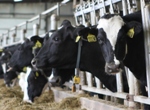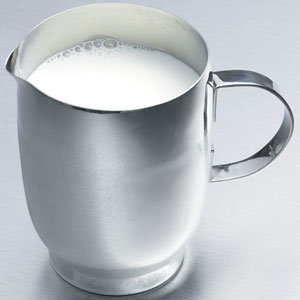 Strong Start to New Insurance Safety Net Program
Strong Start to New Insurance Safety Net Program
ARLINGTON, VA – The U.S. Department of Agriculture announced today that more than half of U.S. dairy operations have enrolled in the new Margin Protection Program (MPP) for dairy in 2015, “an encouraging start to this crucial new safety net program for our industry,” said Jim Mulhern, President and CEO of the National Milk Producers Federation.
The USDA reported Monday that more than 23,000 dairy operations signed up for the program during the three-month window that ran until December 19, 2014. That sum represents about half of the overall number of dairy farms in America.
“The margin protection program is a welcome improvement to federal dairy policy, and comes at an important time to help farmers deal with what will be a more challenging economic outlook in 2015,” Mulhern said. “The MPP is now the only widely-available tool to help farmers protect against both lower milk prices and higher feed costs. It represents a new paradigm in shared responsibility between farmers and the government to cover the cost of that insurance.”
While the USDA has yet to release the volume of U.S. milk production covered under the program, anecdotal reports indicated that the sign-up extensions granted after Thanksgiving, coupled with a sharp downturn in milk price forecasts for 2015, encouraged additional participation prior to the December 19 cutoff.
NMPF expressed appreciation to the Agriculture Department for allowing additional opportunities for dairy farmers to insure themselves through the MPP.
“Secretary Tom Vilsack is to be commended for maximizing the opportunity for farmers to use this new tool,” Mulhern said.
He also thanked the leaders of the Agriculture Committees for establishing the MPP in the farm bill passed last year in Congress – in particular, Senate Ag Chair Debbie Stabenow, Ranking Republican Thad Cochran, along with House Ag Chair Frank Lucas, and Ranking Democrat Collin Peterson. These leaders, along with Senator Patrick Leahy, “fought for the new program, and helped establish a discounted premium rate for the program in 2015 to incentivize first-time enrollment,” Mulhern said.
The next MPP sign-up period will begin in six months, during an open season enrollment window for MPP coverage in calendar year 2016. That enrollment period will run from July 1 until September 30th.
NMPF established its www.futurefordairy.com website to help educate farmers about the program, and worked with USDA and a group of university agricultural economists during 2014 to explain the benefits of utilizing the Margin Protection Program.
The National Milk Producers Federation, based in Arlington, VA, develops and carries out policies that advance the well-being of dairy producers and the cooperatives they own. The members of NMPF’s cooperatives produce the majority of the U.S. milk supply, making NMPF the voice of more than 32,000 dairy producers on Capitol Hill and with government agencies.

 The National Milk Producers Federation (NMPF), U.S. Dairy Export Council (USDEC) and International Dairy Foods Association (IDFA) joined other food and agricultural organizations in support of additional changes in U.S. policy to facilitate U.S. dairy exports to Cuba and permit open travel for all Americans to that nation. The dairy organizations are members of the U.S. Agriculture Coalition for Cuba, a coalition of more than 30 trade associations and companies championing an end to the U.S. embargo against Cuba.
The National Milk Producers Federation (NMPF), U.S. Dairy Export Council (USDEC) and International Dairy Foods Association (IDFA) joined other food and agricultural organizations in support of additional changes in U.S. policy to facilitate U.S. dairy exports to Cuba and permit open travel for all Americans to that nation. The dairy organizations are members of the U.S. Agriculture Coalition for Cuba, a coalition of more than 30 trade associations and companies championing an end to the U.S. embargo against Cuba. The U.S. dairy industry today applauded a commitment to stronger protections for common food names resulting from just-concluded trade talks with China.
The U.S. dairy industry today applauded a commitment to stronger protections for common food names resulting from just-concluded trade talks with China. The National Milk Producers Federation said today a new food safety study from the U.S. Centers for Disease Control and Prevention presents a powerful argument against efforts to ease restrictions on the sale of raw milk to consumers.
The National Milk Producers Federation said today a new food safety study from the U.S. Centers for Disease Control and Prevention presents a powerful argument against efforts to ease restrictions on the sale of raw milk to consumers. Emily Metz Meredith, vice president for animal care at the National Milk Producers Federation, was honored today as a Rising PR Star by a leading newsletter for communications professionals.
Emily Metz Meredith, vice president for animal care at the National Milk Producers Federation, was honored today as a Rising PR Star by a leading newsletter for communications professionals. Farmers have two more weeks to sign up for the revamped dairy safety net included in the 2014 farm bill. The Agriculture Department extended the enrollment deadline for the
Farmers have two more weeks to sign up for the revamped dairy safety net included in the 2014 farm bill. The Agriculture Department extended the enrollment deadline for the  In early December, the House passed and sent to the Senate a one-year extension of more than 50 expired tax breaks, including an important one for farmers that NMPF strongly supported. The Senate is expected to pass the so-called “tax extenders” bill before adjourning for the holidays, but it is uncertain whether it will be identical to the House bill.
In early December, the House passed and sent to the Senate a one-year extension of more than 50 expired tax breaks, including an important one for farmers that NMPF strongly supported. The Senate is expected to pass the so-called “tax extenders” bill before adjourning for the holidays, but it is uncertain whether it will be identical to the House bill. In the wake of the Obama administration’s action last month to delay deportation for up to five million undocumented immigrants, NMPF joined other agriculture groups in re-emphasizing the need for comprehensive reform of the broken immigration system.
In the wake of the Obama administration’s action last month to delay deportation for up to five million undocumented immigrants, NMPF joined other agriculture groups in re-emphasizing the need for comprehensive reform of the broken immigration system.



